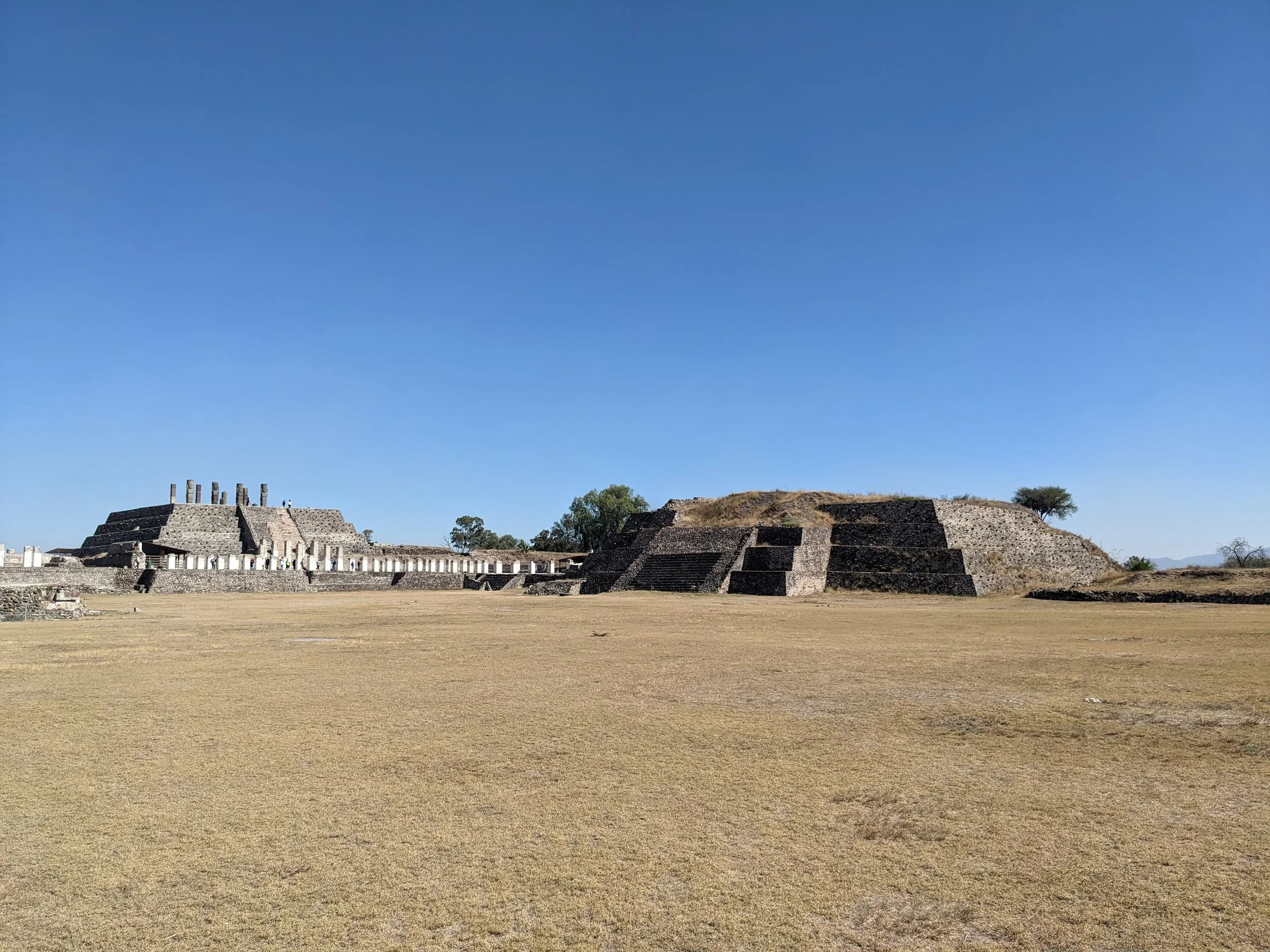












From World History Encyclopedia - https://www.worldhistory.org/Toltec_Civilization/ …
The Toltec Civilization flourished in ancient central Mexico between the 10th and mid-12th centuries. Continuing the Mesoamerican heritage left to them by earlier cultures, the Toltecs built an impressive capital at Tollan. Ultimately, they passed on that heritage to civilizations such as the Aztecs, who regarded the Toltecs as a great and prosperous civilization, even claiming descent from them.
Most information on the Toltec comes from Aztec and Post-colonial texts documenting earlier oral traditions. However, these are by no means complete, and information can be coloured by the Aztec's particular reverence for all things Toltec and their delight in merging myth with fact to help establish a lineage with these old masters. Nevertheless, a careful comparison with earlier Mayan texts and the surviving archaeological record does allow for at least the main elements of this civilization to be outlined.
Origins & Spread
The Toltecs had roots in the Tolteca-Chichimeca people, who, during the 9th century, had migrated from the deserts of the north-west to Culhuacan in the Valley of Mexico. According to the Aztecs, the first Toltec leader was Ce Técpatl Mixcoatl (One Flint Cloud Serpent, i.e. the Milky Way), and his son Ce Acatl Topiltzin (One Reed Sacrificer, born in either 935 or 947) would go on to gain fame as a great ruler and acquire the name of the great god Quetzalcoatl ('Feathered Serpent') amongst his titles.
The first settlement of the Toltecs was at Culhuacan, but they later established a capital at Tollan (or Tula, meaning 'place of reeds', a general Mesoamerican phrase to apply to all large settlements). The city grew to an area of 14 km² and acquired a population of between 30,000 and 40,000. The heart of the city was laid out in a grid pattern and it is remarkably similar to the Mayan city of Chichen Itza. Intriguingly, the Maya also had a version of a cultural hero known as the 'Feathered Serpent', translated as Kukulcan and contemporary with the Toltec Quetzalcóatl; this and architectural similarities, suggest that there was a close cultural link between the two civilizations.
Tollan
The Tollan of Aztec mythology was renowned for its sumptuous palaces and awe-inspiring buildings made from gold, jade, turquoise, and quetzal feathers. The city was also thought to have been flooded with wealth generated by the gifted Toltec craftsmen, highly skilled in metallurgy and pottery - so much so that their potters were said to have 'taught the clay to lie' (Coe, 156) and later Aztec metal-workers and jewellers were even known as tolteca. The Toltecs were also credited with mastering nature and producing huge maize crops and natural coloured cotton of red, yellow, green, and blue. Unsurprisingly, following centuries of looting, no artefacts survive to attest this material wealth except indications that the Toltecs did do a major trade in obsidian (used for blades and arrowheads) which was mined from nearby Pachuca.
The archaeological site of Tollan, sitting on a limestone promontory, although not quite as splendid as the legend, nevertheless, has an impressive number of surviving monuments. These include two large pyramids, a collonaded walkway, a large palace building, and two ball-courts, all surrounded by a dense area of urban housing. The domestic housing is arranged in groups of up to five flat-roofed residences with each group centred on a courtyard with a single altar and the whole surrounded by a wall.
Surviving architectural sculpture on the pyramids includes large columns, each consisting of four drums, carved as warriors standing atop the five tiers of the 10 m high Pyramid B. The warriors would once have held up a roof structure. The warriors are dressed ready for battle with a drum headdress and butterfly pectoral and each holds an atlatl or spear-thrower at their side. In addition, feathered-snake columns survive from the original doorway. The warrior columns are near-identical and suggest sophisticated workshops capable of mass production.
Friezes run around the pyramids and a free-standing 40 m long L-shaped wall (known as a coatepantli and a Toltec innovation). They show scenes with animals such as the jaguar, wolf, and coyote (symbols associated with a warlike people like the Toltecs), and sacrifice (especially rattlesnakes and skeletons intertwined). There are also images of feathered creatures (perhaps jaguars) and eagles with hearts in their mouths.
Tollan also provides the first examples of chacmools, the reclining stone warriors clutching a vessel on their stomach to receive sacrificial offerings for the gods. These would become a common feature of temples in Mesoamerica. At Tollan they are positioned beside bench-thrones atop the pyramid temple.
Decline
What ended the Toltec civilization's regional dominance is not known. A warlike people, no doubt conquering surrounding tribes and imposing tribute without any concern for integration into the Toltec political and religious culture, the 'empire' may well have simply disintegrated when put under the strain of such natural phenomena as a sustained drought. Internal disputes may also have led to the break up of the power structure, and this is hinted at in the legendary stories of battles between the gods Quetzalcoatl and Tezcatlipoca, intertwined with historical figures. What is more certain is that in the mid-12th century, Tollán shows signs of violent destruction; many architectural columns and statues were burnt and purposely buried and the site was systematically looted by the Aztecs. Led by the final Toltec leader Huemac, the remnants of the Toltec people re-settled at Chapultepec on the west banks of Lake Texcoco, an event traditionally dated either 1156 or 1168.
Legacy
The Toltec name carried a certain prestige and they were very highly regarded by the Maya and the Aztecs, in particular, who seem to have copied many aspects of Toltec religious practices and art and looked on the Toltec period as a golden era when such wonders as writing, medicine, and metallurgy were invented. These may well have been invented earlier and by others but more certain is the Toltec influence on architecture and sculpture. Images of recognisable deities at Tollan which would later appear in the Aztec pantheon include Centeotl, Xochiquetzal, Tlahuizcalpantecuhtli and the feathered serpent identified with Quetzalcoatl. Stone carvings of cuauhxicalli vessels and chacmools used in sacrifices and also tzompantli (skull racks) all attest to the influence the Toltecs would have on their more famous successors. In any case, whatever the actual legacy of the people of Tollan, for the Aztecs it was the Toltecs and no other that they sought to claim descent from, and the magnitude of their reverence and respect is evidenced in the Aztec expression Toltecayotl or 'to have a Toltec heart' which meant to be worthy and to excel in all things.






